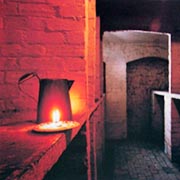|
1740 |
The population of Brighton fell to an all time low of 1,000-1,500. |
|
1750-53 |
First edition of Dr Richard Russell’s book advocating sea bathing as a cure and his move to Brighton to open a house and treatment centre. |
|
1760 |
Mr Baker’s circulating library opened on the east side of the Steine, The Steine was now the fashionable centre of Brighton. |
|
1762 |
Birth of George Augustus Frederick, Prince of Wales, later to become Prince Regent and King George IV. |
|
1764 |
First plays performed in barn in Castle Square. |
|
1769 |
Dr Awsiter’s baths built in Pool Valley. |
|
1771 |
First visit of the Duke of Cumberland (Prince of Wales's uncle), who became the leader of the hunting, racing and gambling set. |
|
1774 |
Opening of a prominent theatre in North Street managed by Roger Johnstone. |
|
1775-6 |
New Assembly Rooms opened at The Old Ship Hotel and Castle Inn. |
|
1783 |
The Prince of Wales’s first trip to Brighton to visit his uncle. The start of the Brighton Races. |
|
1785 |
Secret marriage of the Prince of Wales to Maria Fitzherbert. |
|
1786 |
North and South Parades built. |
|
1787 |
The first rebuilding of the Prince’s house on the Steine by Henry Holland. It became known as the Marine Pavilion. Cobble and brick, bow fronted houses were being built around The Steine. The Lanes was also being rebuilt in the Georgian style. |
|
1793-1815 |
Wars with France (with a brief respite by the Peace Treaty of 1802). Soldiers, including the Prince of Wales’s regiment camped and trained on the site of Regency Square |
|
1795 |
Prince of Wales married Princess Caroline of Brunswick. |
|
1798 |
Building of Royal Crescent by J.B. Otto, a west-indian speculator. |
|
1803-8 |
Building of the Royal Stables in an Indian style, now The Dome. |
|
1811-20 |
The Regency: George III was declared mad and his eldest son became Prince Regent. |
|
1815-23 |
Nash’s external and internal alterations to the Prince’s house which became known as the Royal Pavilion. |
|
1819 |
The Royal Albion hotel opened (on the site of Dr Russell’s house). |
|
1819-22 |
Kings Road rebuilt. |
|
1820 |
The Prince Regent is crowned George IV. |
|
1821 |
Sake Dean Mahomed’s ‘Shampooing & Vapour Baths’ opened. |
|
1822 |
Opening of John Ireland’s Pleasure Gardens and Cricket Ground |
|
1823 |
Opening of the Chain Pier. Charles Busby moved to Brighton to work with Amon Henry Wilds at the invitation of Thomas Kemp. |
|
1823 |
Start of the Kemp Town building project. The first houses occupied in 1826 although some parts were not completed until after 1850 when some sections were sold to the London developer Thomas Cubitt. |
|
1824-28 |
Brunswick Town building began in Eastern Terrace in 1824. The first houses were ready for occupation in 1826 and the Terrace was finished in 1828. The Square was begun in 1825 and also complete by 1828. The northern end and the small round facades in the Square were later. |
|
1825 |
Display of the designs of both Kemp Town and Brunswick Town at the Royal Academy. The ‘Wilds & Busby’ partnership ended. |
|
1827 |
King George IV’s last visit to Brighton. |
|
1830 |
Accession of William IV. Building started on Adelaide Crescent and is an example of the transition from Georgian to the Victorian Italinate style. Completed in 1860. |
|
1832 |
Trial journey of Walter Hancock’s steam driven coach on the London to Brighton road. The journey took six hours. |
|
1837 |
Accession of Queen Victoria. |
|
1841 |
Opening of Brighton Railway Station (21st September). The journey between Brighton and London by express train was 1 hour 45 minutes. |
|
1850 |
Queen Victoria sold the Royal Pavilion to the town of Brighton for £52,000 preferring the peace and solitude of Osborne House on the Isle of Wight which she had built at her own expense in 1845. |



